As most people, I have a lot of personal experience from what we commonly perceive as ‘stress’. It is a word which is notoriously misunderstood and misused in many circumstances. I sincerely hope that you learn a bit more about ‘stress’ from reading this blog and you therefore can avoid unnecessary suffering. Let’s therefore begin by trying to understand what ‘stress’ really is.
What is stress?
The word “stress” unfortunately has multiple definitions, interpretations and it is very often used out of context or intentionally wrong. For instance, in most advertising, it is often falsely described as something negative or vague. This vagueness makes it possible to sell virtually anything with the argument of ‘improving stress’. In everyday language we use the word ‘relax’ for this process of ‘loosening’ or decreasing stress. Since relaxing is a positive but also vague word based on stress then advertisers naturally use it whichever way they like since they cannot be sued for false marketing. Stress or relaxation have no agreed overall set of medical biomarkers and if markers such as cortisol are used, it is very difficult to prove cause and effect. I have never seen an advertisement accurately trying to describe if they mean ‘physical or mental’ stress when using the word relax.
Why is stress considered bad?
The history of modern negative stress began in 1936 when a Hungarian scientist (Selye) discovered that the pain which mice experienced from injections was actually the main reason that they had higher stress – which then made them sicker. He made a simple conclusion – stress makes you sick. The pain triggered a stress reaction which – what he didn’t know then – was reducing immunity as it was lowering the Vagus nerve cholinergic immune system response (I have described this in my blog about ‘Pain and the Vagus nerve’). As in many misunderstood discoveries –false conclusions were made, marketed widely and ‘stress’ became the culprit for humanity’s many ills. Only recently has stress become better understood and its reputation is recovering.
Kelly McGonigal (Lecturer at Stanford), in her book ‘The upside of stress’, is describing a multitude of stress studies with hundreds of thousands of persons. The common conclusion in these is the surprising finding that mental stress is only harmful if the person ‘believes’ that it is harmful. She is also describing how ‘successful’ people in general perceives stress as positive – in contrast to those less successful who think it is detrimental to their life and health. The negative placebo effect is very strong in how we respond to stress. Based on my now ten years of Vagus research, I agree with these conclusions.
This soon 100 year old teaching about stress is an unhelpful relic. We have become the victims of fear mongering. Our animal instincts is for instance that stress actually makes us socially smart – it’s what allows us to be fully human. Let us embrace this instinct.
Stressors
To understand why we are stressed, we need to understand what things stress us and why. We also need to understand that many advertised ‘relaxing’ products actually cause stress.
The word “stressor” is used for something that causes imbalance in the human body = stress. It is a ‘situation or external object’ which is causing changes in the body’s homeostasis. Stressors are broadly divided into biological – where the stressor is externally or internally physical – and mental where the stressor is determined by the mind and nervous systems (the brain or the autonomic nervous system – ANS). Both the magnitude and chronicity of stressors are naturally important for the impact on a person’s consciousness and perception of stress.
I use the concept of “stress response”, as a unitary response of the body to any stressor regardless of its nature. Chronic stress is negative for the body as it can be viewed as a continued undesirable state (negative stress). Peter Levine defined it as the inability of the Autonomic Nervous System to recover to normal functionality. The parasympathetic nervous system (Vagus nerve) is the main part of this system which is working to ‘recover normal functionality’. This state of ‘achieving recovery’ is called ‘homeostasis’ and can be described as balanced state in the body and mind. The biological definition of homeostasis is that there are steady internal, physical, and chemical conditions maintained by the body.
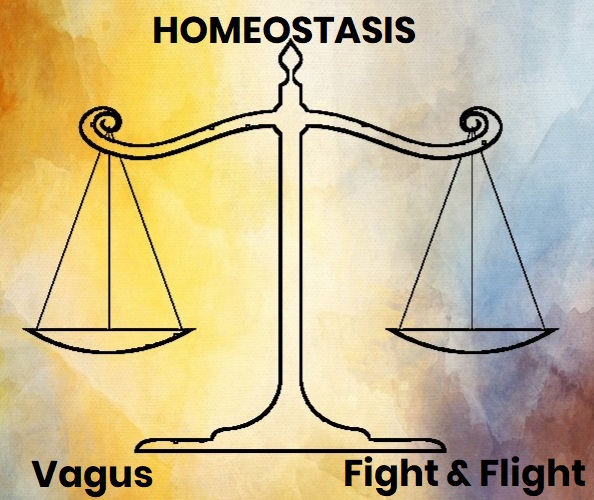
The Vagus nerve
The Vagus nerve is the main and most important part of the parasympathetic autonomic nervous system and its main ‘work’ is to adjust physiological and mental processes to keep homeostasis. Thereby it is the main active part that is reducing stress (imbalance). To measure the Vagus nerve is therefore essential for understanding its activity of stress recovery.
Vagus vs Fight & Flight
Traditionally the Vagus nerve has been described as the ‘opponent’ to the sympathetic nervous system ‘fight & flight’ reactions.
Vagus nerve activity low = stressed:
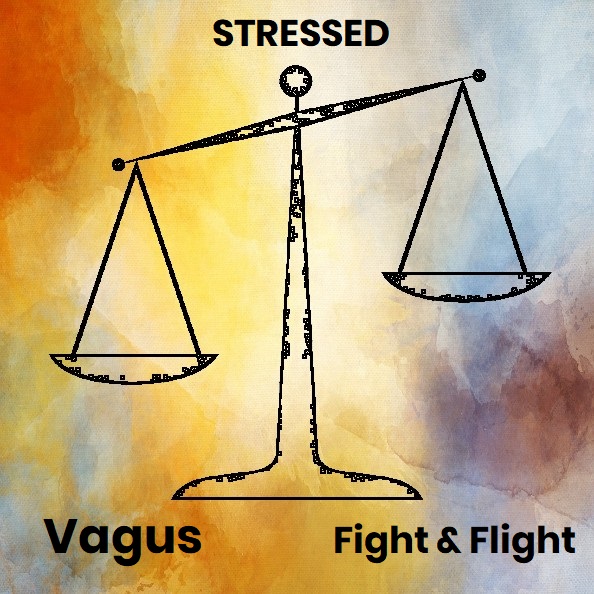
Vagus nerve activity high = relaxed:
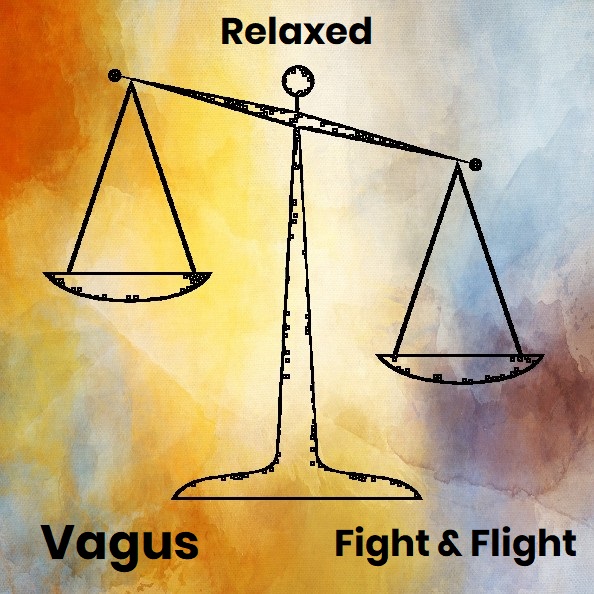
Bad and good stress
The above traditional way to describe stress is naturally not complete and it misses a lot of important issues about stress. Stress is giving the person energy to help do a challenge or for instance fight a disease. If there is not sugar in the gut, stress triggers sugar and fat release from the liver to the bloodstream for fuel. Breathing accelerates and bronchioles in the lung expand so that more oxygen is going to the muscles and brain. Stress hormones like adrenaline and cortisol hep muscles and brain to take in and use this energy more efficiently. In all these ways the stress response helps the person. Adrenaline is activating senses and it improves the perception and speed of processing information in the brain. We all know that mind-wandering usually stops when we are highly stressed. We become good at concentration. In order to keep us motivated to respond to stressors – endorphins testosterone and dopamine is released. This side of stress response is perceived as enjoyable by most. It makes us excited and it forms the ‘thrill’ in for instance exciting sports such as skydiving.
When the stressful is less threatening, the brain and body is shifting into ‘challenge response’. This is the ‘deadline’ stress which makes us focused but not fearful. It releases a different ration of hormones and the Vagus nerve vs Fight and Flight is more in balance but both are ‘higher’ than in a ‘relaxed after a good dinner’ homeostasis state. Some people report this ‘stress’ state as flow and highly enjoyable. Artists, athletes, software coders etc show this kind of stress response when they are fully engaged in what they ‘can and like’ to do.
Stress can also be very positive to social connections. This kind of stress is usually driven by the ‘Vagus’ nerve activated hormone called Oxytocin. According to Stephen Porges ‘Polyvagal theory’ this is also when the ‘ventral vagal’ part of the Vagus nerve is activated. I will not here go into the Polyvagal theory in more detail but I will come back to it in later blogs.
All of the above types of stress are what I describe as ‘good stress’. These are only examples of a few. There are many different types of individual ‘combos’ between stressor-based activation of the vagus nerve and sympathetic nervous system which are perceived by the person as ‘good’ states.
As I concluded before, stress is negative when:
- The person perceives stress as negative
- The stressors are chronic and the Vagus nerve cannot regain homeostasis
- The stress is disease-, injury- or inflammation- (also autoimmune-) based and the molecular and/or cholinergic immune system is in progress and has not been able to regain homeostasis in the body.
I here also want to remind that in my previous blogs I have tried to show that the field of psychiatry and ‘psychology’ – as a ‘genre’ – is the most primitive and unscientific field of medical science today. The way it ‘treats’ stress is generally old-fashioned or outright wrong. Many older unproven opinions and practices are standard care in that field. The positive effects of psychiatry are often caused by time and the placebo-effects.
Measuring stress
The traditional description of stress is that it makes pulse higher; the heart rate variability (HRV) goes down, and breathing quickens. Maybe a person also starts sweating. But while stress has been made into a public health enemy, new research suggests that stress may only be bad for you if you believe that to be the case.
For instance, coffee can be described as a stressor causing above symptoms. But this effect is seldom negative. On the contrary most people consider it as good stress because attention and cognition improves. A certain level of stress is necessary for optimal cognition. Our brains have a homeostatic stress range which for more complex, longer term or more complex thinking requires a higher level of stress than ‘average’. We also know that a mental stressor, such as a deadline, is usually a beneficial stressor. There are many similar examples of good stress. It is very important to be mindful and observe the reality of stress and not let false presumptions negate balanced and positive stress. This can be achieved by objective data to counter old subjective views and beliefs. Stress reactions are always individual and a person should understand her or his own individual ‘settings’.
The aim of Vagus nerve monitoring is to understand when it the body and mind has achieved recovery and the body is in homeostasis – ‘ready for action’. This level and state of the Vagus nerve activity is generally called Vagal tone and it consists of many parts. The VAGUS® ECG test measures several of these components, mainly the heart rate variability (HRV), the respiratory control, the cardiac/respiratory synchronisation, the timing and minimum pulse changes achieved during the standard test protocol of controlled breathing. I naturally recommend it since I invented it to accurately monitor my own stress levels.
Sugar Stress
One example of outright false advertisement is ‘Relax with Coca Cola’ which obviously is a wrong statement according to all definitions of stress and/or loosening of stress. The only relaxing effect Coca Cola has is, when a person is drinking it to compensate for quickly decreasing blood sugar levels. This usually occurs from drinking a previous bottle that has caused the high sugar stress in the first place.
Essentially, Coca Cola is saying that ‘we caused strong stress with the 1st bottle’ so now drink one more to relax the high stress we are causing you. It is a brilliant business model since people don’t usually cognitively perceive the 1st bottle’s stress effect. Science (and my own example later) has clearly shown that drinking Coca Cola is very stressing for the body and the mind. It is therefore relaxing only if one already has a strong sugar imbalance or an addiction for sugar. I agree that Coca Cola may enhance cognition and it can make us happier thanks to the sugar boost – but it is definitively not relaxing (at least not since they took away the cocaine as an ingredient. ).
Example: My Coca Cola test with VAGUS® ECG and the Abbot Glucose Sensor
During the past week I have been testing a ‘Supersapiens’ Abbot sensor which is on my right upper arm. The sensor, which measures blood glucose levels continually and pairs via Bluetooth with the smartphone app. It has a nice graphical display of my blood glucose levels over time. It updates the value once per minute. It is an interesting tool for learning how the body’s sugar levels are reacting to foodstuffs and exercise.
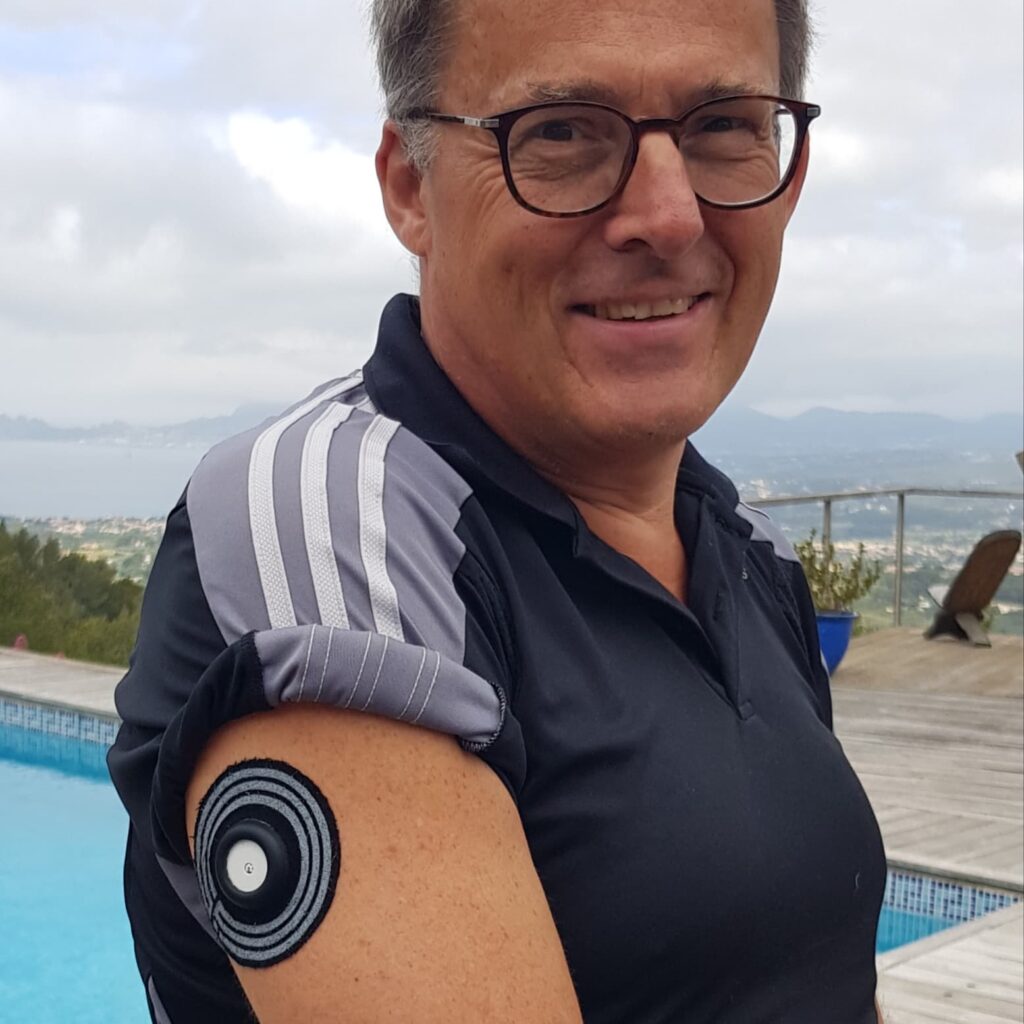
I decided to tested my reactions to s small bottle of original Coca Cola (250) ml. I measured my VAGUS ECG values before gulping down the whole bottle. Within about 5 minutes my blood sugar levels started go up from my average starting level of 90 mg/dl. 10 minutes after drinking, my sugar level started to rise rapidly. 35 minutes after drinking my sugar level peaked at 151g/dl. It was shocking to see how quickly and how high it went – beyond anything I had ‘reached’ during the previous week. I did a VAGUS ECG test every five minutes but to my surprise I did not notice any changes during this upward trend. It seemed that the Vagus didn’t care.
My sugar peak at 151 mg/dl:
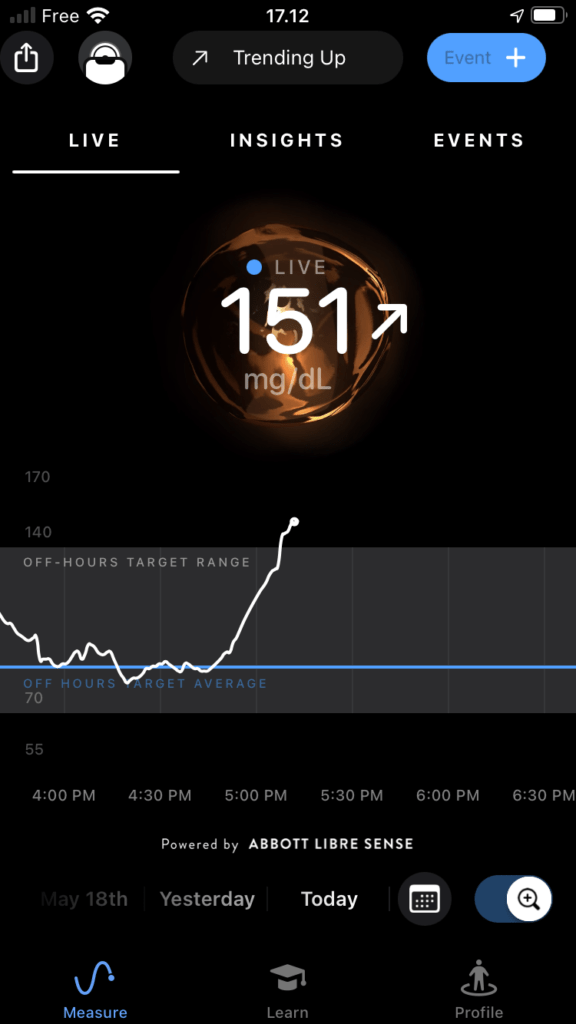
The most interesting development started to occur 15 minutes after my peak sugar level. I started to feel ‘bad’ and I really wanted to drink another Coca Cola or eat chocolate. I could feel micro-vibrations in my hand muscles and I felt the pulse inside my head. I was obviously getting ‘withdrawal’ symptoms from the extreme sugar bomb I just had consumed. Now I could see changes in the vagal tone especially in the cardiac smoothness and pulse. This ‘stress’ moment lasted about 10 minutes until I gave in and had to drink water.
My vagal tone quickly recovered but my mental ‘desire’ to get more sugar remained. It was easy to understand why Coca Cola is such a big company and makes so much money. It’s mainly not because of the ‘pleasantness’ of the drink – it is from the ‘stress’ reaction which makes people to drink more. Pure and simple homeostasis stress which our frontal cortex is trying to solve in the simplest way – drink more…
Tobacco – nicotine
As a mental challenge to the reader, I have to admit that tobacco companies have a much better scientific basis for saying ‘Relax with smoking’ since nicotine is a strong Vagus nerve activating molecule and hence it really normally reduces a person’s stress. The smoke in the lungs though unfortunately does the opposite so the overall stress effect is individual. Do not take this as a recommendation to start smoking.
Recovery
The body relies on a wide range of molecules and neurological pathways to recover from stress. Here again the Vagus nerve is the main ‘player’ for recovery. It initiates immune response via the Cholinergic immune system, activates internal organs and makes molecular neurotransmitters to restore balance. Other parts naturally also play their part and for instance the brain and neural pathways are trying to actively remember and rewire to learn from the stressful instance. Emotions also can run high during this process. Adrenalin imbalance can make the person feel agitated but also fear, shock, guilt, anxiety and sadness can occur during this recover period. It can last several hours. Activating the Vagus nerve is known to speed up recovery. Easy methods are controlled breathing, splashing cold water on the face or doing yoga/mediation.
Summary
- Stress is not inherently ‘bad’, it is a healthy process activated when body- or mental functions are outside their norm-range and not in ‘Homeostasis’.
- Only chronic- or extreme levels of stress (trauma, disease etc) cause longer lasting harm to the body.
- The mind is very important in stress response because if a person considers stress as ‘bad’, then it has a negative effect.
- People who perceive stress as positive are usually healthier and more successful in life.
- The Vagus nerve is the most important component in recovery and decrease of stress.
- Monitoring stress with the VAGUS ECG test is easy and hundreds of our users take daily test to understand more about their stressors, mental reactions and interventions to have a better life.
Have a great day and stop worrying about your stress 😊
Gustaf
Recommended reading and watching:
Kelly McGonigal TED Talk: ‘How to make stress your friend’ 26 million views: https://www.ted.com/talks/kelly_mcgonigal_how_to_make_stress_your_friend?language=en
Book: Kelly McGonical, ‘The Upside of Stress’
Examples on Stress Responses from the paper Somatic Experiencing: Using Introception and proprioception as core elements in trauma therapy, Frontiers of Psychology 2015 by Peter Payne, Peter Levine and Crane-Godrou:
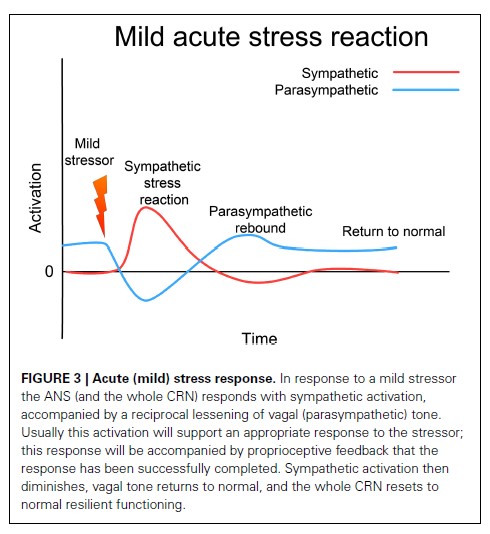
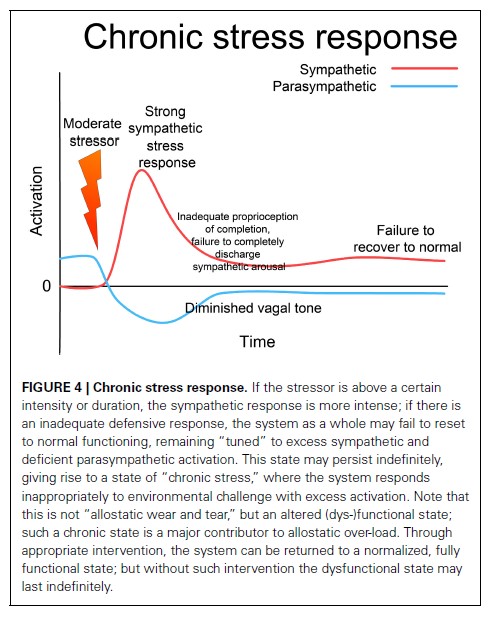
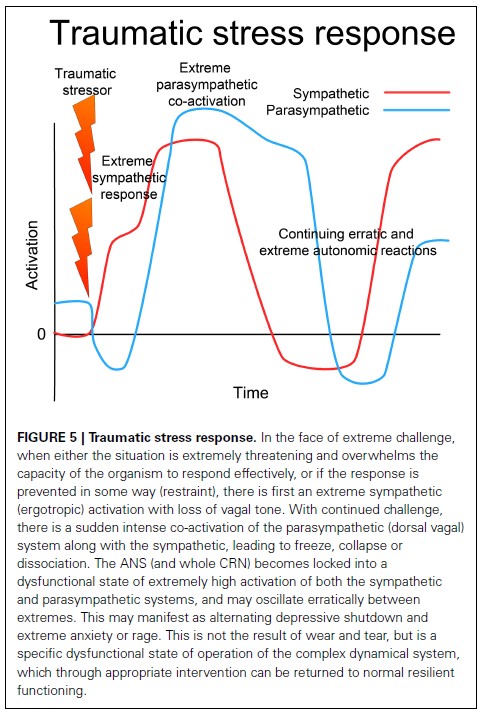
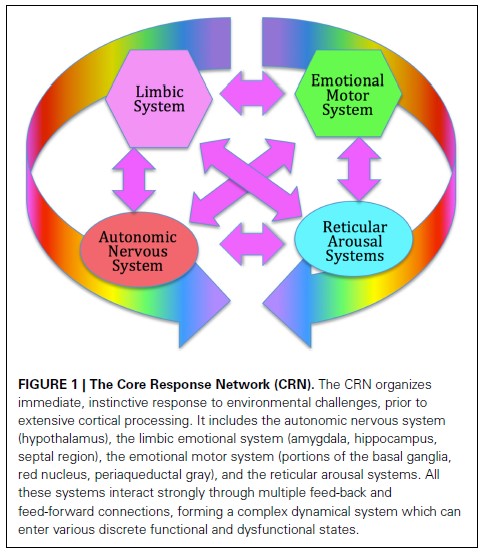
© Gustaf Kranck

